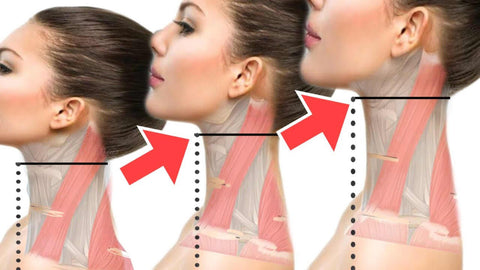At first glance, the jaw and the neck might seem like distinct parts of the human body, each with its own function. However, when one dives deeper into anatomy, physiology, and even the daily experiences of pain and discomfort, the intrinsic connection between the jaw and the neck becomes apparent.
Understanding the Connection
The human jaw, medically termed the mandible, and the neck, comprising a series of cervical vertebrae, share more than just proximity. The temporomandibular joint (TMJ) is the hinge joint that connects the jaw to the temporal bones of the skull. This joint allows the jaw to move up and down, side to side, and facilitates talking, chewing, and yawning.
Beneath the jaw and surrounding the neck are a complex network of muscles, ligaments, and tendons. When the jaw moves, certain neck muscles are also activated, highlighting the functional synergy between these regions.
Jaw and Neck Anatomy
Due to the interconnected nature of the jaw and neck muscles, issues with the TMJ can lead to discomfort or pain in the neck region. For instance, temporomandibular joint disorder (TMD), a condition affecting the TMJ, can result in symptoms such as neck stiffness or soreness. Conversely, neck problems can lead to discomfort in the jaw, highlighting the bidirectional nature of this relationship.
Furthermore, poor posture, especially in today’s digital age, can strain both the neck and the jaw. Slouching or constantly looking down at electronic devices can strain the neck muscles, which, in turn, can influence the position and functioning of the jaw.
Jaw and Neck Muscles
Just as issues with the jaw can affect the neck, the reverse is also true. Conditions such as cervical osteoarthritis or herniated cervical discs can alter the posture and alignment of the neck, indirectly causing or exacerbating jaw pain.
Neck injuries, whether from accidents or from wear and tear, can lead to inflammation that extends to the jaw region, manifesting as pain, stiffness, or limited mobility. Recognizing this interconnected pain can guide more holistic treatments and therapeutic interventions.

Jaw and Neck are Connected
Our body is like a puzzle, with each piece fitting seamlessly into the next. The jaw and the neck, though seemingly independent, are closely connected, both anatomically and functionally. Let’s dive deeper into this connection.
Anatomy of the Jaw and Neck
The human jaw, technically known as the mandible, is a hinged structure that connects to the skull. Directly beneath it is the neck, made up of cervical vertebrae, muscles, and ligaments. The muscles that operate our jaw, such as the masseter and temporalis, have counterparts in the neck that assist in movement and stability.
The Role of Muscles and Ligaments
The muscles and ligaments of the jaw and neck work in harmony. Ever noticed how a yawn stretches not just your jaw, but your neck as well? That’s the handiwork of the interplay between the muscles of these regions. The sternocleidomastoid, for instance, has a vital role in tilting the head and is indirectly related to the jaw’s functioning.
How Issues in One Affect the Other
It’s all fine and dandy until one suffers, bringing the other down with it. Problems like TMJ (Temporomandibular Joint) disorders can lead to neck pain, while neck issues can also manifest as jaw discomfort. The butterfly effect, anyone?
Posture’s Role in the Connection
Slouching on your desk? You might be hurting more than just your back. Poor posture can affect the alignment of the jaw and neck, leading to issues like pain and discomfort. So sit up straight, folks!
How Your Jaw is Connected to Your Neck
Anatomy of the Jaw and Neck
The jaw, or mandible, connects to the skull via the temporomandibular joints (TMJs) located just in front of each ear. These joints facilitate movements like opening and closing the mouth and moving the jaw side to side. The neck comprises cervical vertebrae, muscles, ligaments, and nerves that support the head and enable its movement.
Muscular Connections
Several muscles bridge the jaw and neck, including:
-
Masseter and Temporalis: Primary muscles involved in chewing.
-
Suprahyoid and Infrahyoid Muscles: Located in the neck, these assist in swallowing and stabilize the hyoid bone, which supports the tongue and its movements.
-
Sternocleidomastoid and Trapezius: Neck muscles that influence head posture and can affect jaw positioning.
These muscles work in harmony to coordinate movements of the jaw and neck.
Neurological Connections
The trigeminal nerve, responsible for sensation in the face and motor functions like biting and chewing, interacts with cervical nerves in the neck. This neural interplay means that tension or dysfunction in the jaw can manifest as neck pain and vice versa.
Postural Interdependence
Proper head and neck alignment is crucial for optimal jaw function. Poor posture, such as slouching or forward head posture, can strain neck muscles, leading to misalignment of the TMJ and subsequent jaw pain. Conversely, jaw issues can contribute to neck discomfort.
Common Disorders Linking Jaw and Neck
- Temporomandibular Joint Disorders (TMD): Characterized by pain in the jaw joint and surrounding muscles, TMD can lead to neck pain due to shared muscular and neural pathways.
- Bruxism (Teeth Grinding): Often stress-induced, bruxism can overwork jaw muscles, causing referred pain in the neck.
- Cervical Spine Misalignments: Misalignments in the neck can affect the positioning and function of the jaw, leading to TMD symptoms.
Implications of the Jaw-Neck Connection
Understanding the jaw-neck connection is vital for diagnosing and treating related disorders. Addressing only the jaw or neck in isolation may lead to incomplete relief. A comprehensive approach that considers both areas can enhance treatment outcomes.
Treatment Approaches
- Physical Therapy: Targeted exercises can strengthen and stretch the muscles of the jaw and neck, promoting proper alignment and function.
- Postural Correction: Improving posture can alleviate undue stress on the neck and jaw, reducing pain and dysfunction.
- Stress Management: Techniques such as mindfulness and relaxation exercises can decrease habits like teeth grinding, benefiting both jaw and neck health.
- Masseter: Primarily a jaw muscle, it’s essential for mastication (chewing).
- Temporalis: Another jaw muscle, it aids in closing the mouth.
- Sternocleidomastoid: This muscle runs down the side of the neck and assists in turning the head and neck.
- Digastric Muscle: This muscle has two parts (anterior and posterior) and plays a role in opening the mouth. It connects the mandible (jawbone) to the skull and the hyoid bone in the neck.
- Mylohyoid and Geniohyoid: These muscles lie beneath the chin and assist in elevating the hyoid bone and the tongue during swallowing and speech.








